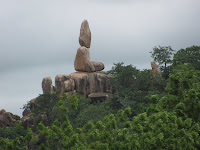For those of us who live in Canada, even in the UK, it is hard to imagine that any place in Africa, let alone Cameroon, could be called the “Extreme North”. But it exists, further north than the North Region (of Cameroon) and of the Far North Region. It is just east of Nigeria, South of Niger and West of Chad. More striking is that is it on the very edges of the Sahara desert. It takes 2 full days to get there from Bamenda and that includes an all night train trip.
As we drive closer to our destination Maroua, the landscape changes. Driving down from low mountains, the savannah displays its short trees and low grasses. Small herds of very skinny cows, goats and several donkeys graze quietly. Scattered here and there are traditional thatched huts, usually huddled in a group. The huts are not very big; I understand that there is usually one for each wife and her children and there may be one for storage. Of course, the head of the family has his own. It is a tough life for these villagers who have no electricity and no running water.
The rainy season has just begun in the Extreme North. That means that fields that are normally expanses of sand are showing some green: short grasses and the new shoots of the annual crop – maize, cotton, millet. In the middle of Maroua, there is even a small field of rice. However good that sounds, there is a real shortage of food. The rainy season came late and so the crops are late. Last year’s stock is long gone and market prices are up. People do not have sufficient food and a large number of the population is mal-nourished. Fruit is rare. If you have been following the crisis in Niger, it is working its way down to the Extreme North of Cameroon.
Our stay there was none the less pleasant. We stayed in a newer hotel with a good restaurant and a comfortable terrace. The rooms are clean, with A/C and hot water showers. The rooms are arranged around a treed courtyard where geckos of varying sizes and colours scuttle about. The only annoying part was the large amount of house flies and mosquitoes. (Canadian mosquitos may be big but you can hear them coming and the sting does not continue for three days. More importantly, they do not carry malaria!)
Dave and I were part of an exchange trip: representatives from two NGOs and two village councils were meeting a similar contingent from the Extreme North. We had four days of exchange and one day a VSO only meeting. It was great to greet colleagues and meet new friends. One morning, we went on a field trip to a counsel and then to a cotton and millet farm. On the way back, we spotted the 'sacred' mountain with a natural rock formation that resembles a sitting budha. Quite amazing! The meetings were useful, though long drawn (time management is no one’s strong suit in Cameroon!). I felt like I was back in Canada as there were both French and English speakers and everything had to be translated. There was an excellent exchange of ideas and commitments to continue to learn from each other.
Part of our group made a very interesting visit to the Lamido (tribal chief) of one of the tribes. He received us in a carpeted room with little furniture. Shoes were left at the door and we discovered later that women were not supposed to enter without head cover – wish we had been told. The Lamino was quite gracious however, sitting on a sofa rather than his elaborate throne. He gave us an expose of the tribe’s history and patiently answered questions from the audience – first in his native language, then in French , then in English. The Lamido is a tall, smart and handsome man so it was not surprising to hear that he had 4 official wives, one ‘unofficial’ wife and 16 chilldren.
Not sure I will ever be back in the Extreme North but it is a trip I will not soon forget.
Saturday, 7 August 2010
Subscribe to:
Post Comments (Atom)






No comments:
Post a Comment